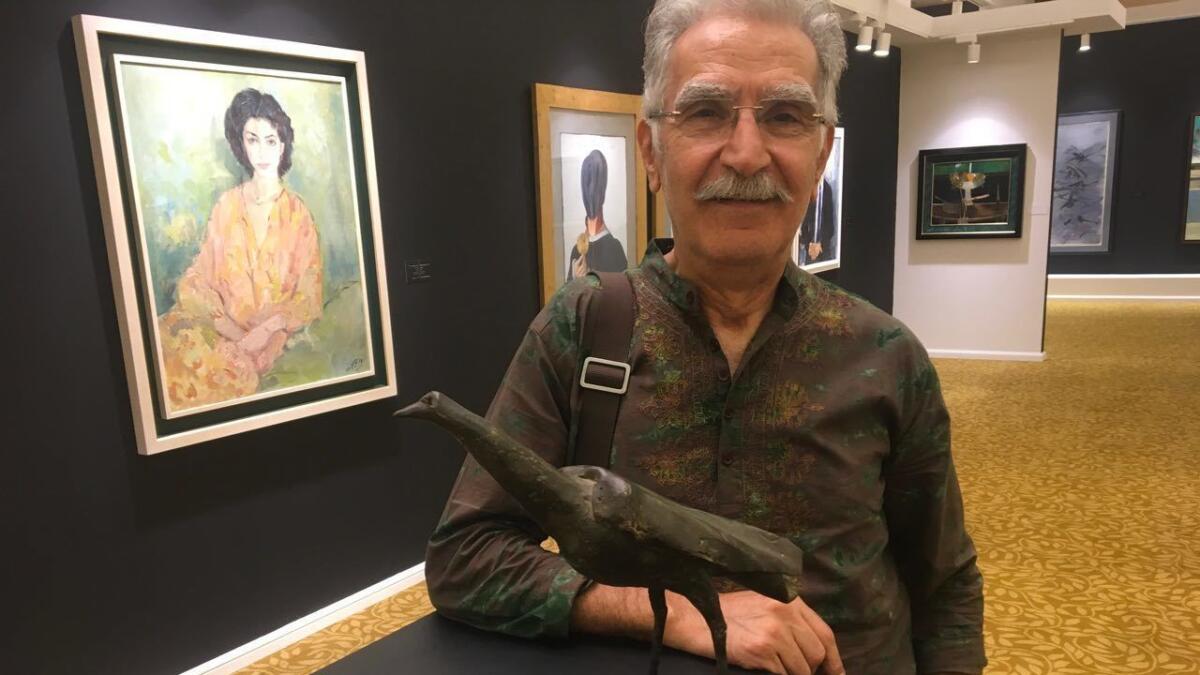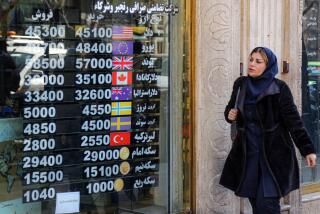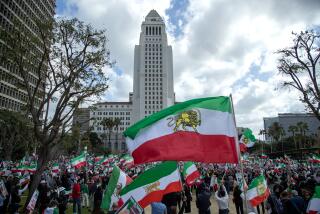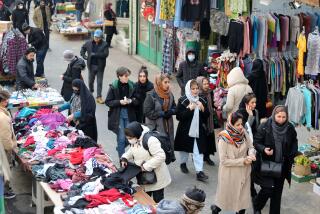On the Ground: U.S. sanctions hurt, but Iran’s wealthy find solace in art
- Share via
Reporting from Tehran — In Tehran’s towering Azadi Hotel, a stone’s throw from one of the most notorious prisons in Iran, an elegant, gold-carpeted ballroom was lined with paintings bathed in soft light.
For two days last week, dozens of works created by artists who were born and whose careers flourished before the 1979 Islamic Revolution were on display to the public. Inside the hushed gallery, the classical and modern paintings shone like rays of light amid gloomy news elsewhere: a plummeting currency, renewed U.S. sanctions, protests breaking out across the country.
The Tehran Auction has taken place at least once a year since 2012, amid the ups and downs of the Iranian economy. The ninth edition of the auction offered a temporary distraction for a small group of well-to-do art collectors and a chance to invest in something that might actually hold its value in the Islamic Republic.
Some of the art defies hard-line Islamic teachings that depictions of the human form are blasphemous — but Iran’s clerics sometimes turn a blind eye to secular pursuits as they try to manage the public mood.
On the second day of the viewing, 70-year-old Ebrahim Eimani, sporting a gray mustache and patterned brown tunic, gazed at a pair of paintings by the artist Aydin Aghdashloo. The “Enigma” works depict two women side by side holding large coins, their heads resembling colored prunes.
Eimani, a former model and salesman who acted in commercials in the 1960s, started a company that sold ready-to-wear fashions for women in the years before the revolution. His business did well, allowing him to amass a small private art collection, but he eventually lost ground to cheaper, imported dresses and switched to manufacturing polyethylene-based containers.
That venture was suffering now too as a result of the diminishing value of Iran’s currency, the rial.
“The prices of raw materials from domestic petrochemical companies have more than doubled, and we can hardly make ends meet,” Eimani said, leaning against a pedestal that held a small sculpture of a crow by Bahman Mohasses, an acclaimed artist who died in 2010.

For five years Eimani’s company has earned just enough revenue to cover expenses and his employees’ salaries. He had recently invited a Spanish businessman to discuss upgrading his equipment, but worried that U.S. sanctions would make it impossible.
He looked at the paintings and saw more than just works to add to his collection.
“Now with the prices of these pieces, I am thinking of selling my private collection,” he mused. “In this dire economic situation, my art collection can save me from bankruptcy.”
It was difficult for any art lover to leave financial worries at the door.
Homa Taraji, a curator from Los Angeles who is the auction’s head of international relations, said that the combined value of paintings sold last year was $7 million, with organizers collecting a 20% commission from sellers. But the paintings are sold in rials, whose value has plummeted from about 36,000 to the dollar a year ago to the black market rate of 80,000.
Voria Hashemi, the owner of a gallery near Tehran’s Vanak Square, brought his wife and children to view the paintings the day before the auction. A segment of Iran’s elite — many of whom have become rich off connections to state-owned businesses and live in luxurious apartments in Tehran’s leafy northern districts — sees art as a good investment as the rest of the economy implodes.
“It’s lucrative in comparison with other kinds of investment, and at the same time it will encourage young artists to stick to their art and be hopeful someday their creative talents will be appreciated,” Hashemi said. “Art cannot grow without rich sponsors and a society that appreciates it.”
But the event did not draw only the wealthy. Hasan Akbari, an unemployed 35-year-old who lives with his parents, brought his girlfriend to marvel at works such as an untitled canvas of a village at the edge of a desert, painted in the 1970s by the late Sohrab Sepehri.
“For sure, we common people cannot afford these, but at least we can come and appreciate them before they vanish in the private houses of the rich,” he said.
The following evening, the ballroom was filled with more than 800 well-dressed members of Tehran high society — men in rakish, slim-cut suits with shirts open at the neck, women in Christian Dior head scarves wrapped around salon-fresh hairdos.
Buyers greeted one another like members of a club, settling into red banquet chairs and snapping photos with expensive cellphones.
Hossein Pakdel, a renowned theater actor with a luxurious silver mane, served as the auctioneer, reading out lot numbers and prices in a beautiful cadence. The bidding was fierce and done mostly by women who raised their placards with practiced nonchalance.
Most of the 140 registered bidders had participated in previous auctions. But few wanted to speak to a Times journalist, perhaps aware of how this scene would appear to the vast majority of Iran’s 80 million people.
The canvas by Sepehri sold for more than $637,000 at the black-market exchange rate — by far the most expensive of the night.
Among the buyers was a 42-year-old engineer who gave his name only as Hamid, who paid 700 million rials — about $8,750 at the unofficial rate — for a painting of a French village by Abolhassan Sadighi and about $5,000 for “Tasseography,” a painting of an overturned coffee cup by Siavosh Kasraei. (It was the lowest amount paid for any of the nearly 80 works that sold, for a combined value of nearly $4 million.)
Hamid, who collects silverware, said it was the first time he had participated in the auction.
“I bought ‘Tasseography’ for passion, but I bought the second as an investment,” he said. “The future of my business as an engineer and my share of a private factory is not promising. I’m shifting to art as an investment — it’s close to my heart and it’s a good business with a good future.”
Mostaghim is a special correspondent. Times staff writer Shashank Bengali in Islamabad, Pakistan, contributed to this report.
More to Read
Sign up for Essential California
The most important California stories and recommendations in your inbox every morning.
You may occasionally receive promotional content from the Los Angeles Times.













